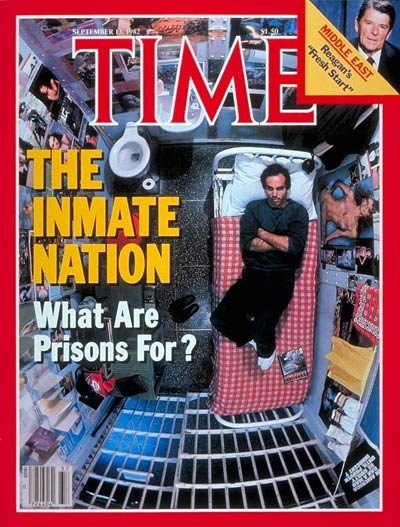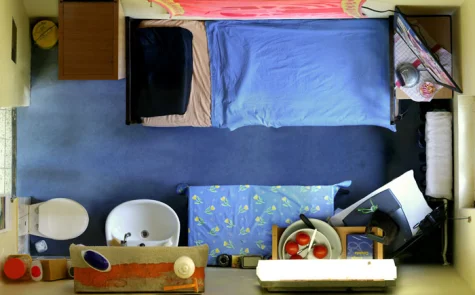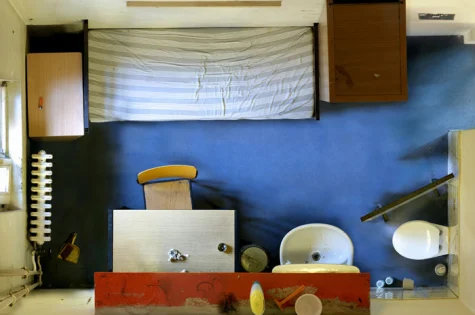You are currently browsing the tag archive for the ‘Jurgen’ tag.
I recently came across this 1982 Time Magazine cover. It immediately reminded me of Juergen Chill’s Zellen series that I blogged about some months ago.

Time Magazine Cover, September 1982
The early eighties signal the end of innocence for America’s criminal justice system. Reagan ushered in an era of extreme punitive sentencing and the most rapid prison expansion of any democratic society ever. That said, you’d hope that with 27 years experience under our belts we’d have some firm answers for the 1982 journalist, huh?

© Juergen Chill
View all Monday Convergences

In 2007, Jürgen Chill‘s Zellen series won him the European Architectural Photography Prize in the “Favorite Places” category. Awarded every two years since 1995, the international prize is now organized by the nonprofit architekturbild.eV (since 2005). The 2007 jury – chaired by Hans Eberhard Hess, chief editor of Photo International magazine – was impressed by Chill’s strict central overhead perspective and chose four images.
Today, the 2009 prize winners are announced, so it seems like a good time to recall Chill’s intriguing images.
Jürgen Chill’s Zellen photographs are a unique perspective upon prison space. Of all the positions in the cell, this floating light-fixture-eye-view should be the least claustrophobic, and yet, the central (physically impossible) high vantage point is dizzying. How does the camera (let alone cameraman) take up such a position? From here, what is there left to do but fall?
Has Chill has pioneered a new photographic typology? I was fascinated by the order of each work; the order of each cell. I must presume this order is the inmates doing and not the photographers. Chill’s work is labour intensive. The reason he nor the camera falls is because each image is a stitch of over one hundred photographs, captured by a digital SLR mounted on a boom, pressed – facing downward – against the ceiling surface.



Chill is aware that entering his work in the category ‘Favourite Places’ may seem careless or even cynical, especially as the inmates are not pictured. On the other hand, as he notes on his website, “the barren rooms of the inmates are highly individualized and at least temporary qualify as de facto ‘Favorite Places’.” In 2006 he stated:
A person’s favourite place is a place which can be chosen at will. The person’s freedom is presupposed. Freedom, however, is not granted to all. Those that do not have it must adjust to whatever opportunities exist and strive to create their own place. A cell is perhaps the smallest possible space for habitation that a person can have. Personal and functional items are all accommodated in the tightest space. The spaces are represented as they are found. The Spaces are represented as they are found. The proportions of the photographs mach those of the rooms. All details in the rooms are shown orthogonally from above, nothing has been altered.
________________________________________________________________
I contacted Jürgen via email to ask about the practicalities of making Zellen, and to secure his comments on the series concept.
Jürgen, please introduce your work.
My photographs are most like a map of the prison cells; like a Google Earth view of a landscape. I try to communicate information about the individuals that have to live in perhaps the smallest possible space for habitation that a person can have – without showing this person himself. Personal and functional items are all accommodated in the tightest space.
I’m interested in how a person arranges personal and functional items in their small cell. And what kind of person can it be [based upon the visible evidence]? Is it possible to get a “picture” of a person by having a view of his private space? It’s a view and perspective that you normally would never get of these cells. So it is not really “real”, more a scenery set or something similar.



Where are the cells?
The are all in Germany in big cities in the area of Nordrhein Westfalen.
Are the photographs made in the same institution?
I made 16 photographs in 6 different prisons in the cities of Bochum, Hagen, Duisburg, Gelsenkirchen, Essen and Geldern
Where were the prisoners when you took the photographs?
I had a short conversation with the prisoners in their cells; explained my project, my concept and my motivation. Some of them were really interested in my work and my kind of photography. The prisoners allowed me to spend about 45 minutes alone in their cells, while they are waited outside, in the alleyway, guarded by one or two persons from the prison.
After my work, for their permission to photograph and publish their private things and space, I gave them a small gift; a packet of coffee or cigarettes. Later I sent them all the photograph of their rooms. Some of them asked for it to have as a kind of souvenir for when they are released from prison.
How long did set up take and what equipment did you use?
Just to photograph takes about 30 minutes. With the test shoots and everything it takes about 75 minutes in one cell. The main work, the montage to one photo takes about one week. So it took a long time to make the photo series. You can see how the images were made in the youtube clip of this German television show from October, 2007.
Does the collection and order of all worldly possessions in a single space fascinate you?
It’s the combination of personal and functional items in a small space. First, the cell must contain all the functions of a house in one room: bedroom, toilet, living-room, store-room and sometimes a kitchen. Then the prisoner combines it with his personal possessions and create his private space in about 8 square metres. How does a person arrange such a small space with personal items so that it [also] keeps its basic functions ? And that arrangement exists for years. So my photographs try to draw a picture of an individual person.

Americans, in particular, are starting to realise that they must use/waste less petrol, possessions, energy, space and give up personal largess for the benefit of community. Does the modesty of the prison cell appeal to you? Do future modes of living relate to the cell?
For me, as the artist and maker of these photographs, my intention is not to call out [to people] to give up personal largess for the benefit of community or for other kinds of social and political attitudes or activities. I just want to show the state of things in the visual of photography and try to show these things in an unusual perspective or context. Just to ask questions about it and not to give answers. That’s the viewers job.
Would you put your images into a history of visual culture that represents humans under duress and finding humanity in the smallest places/between the cracks? Or, is the Zellen series a totally modern piece, completely divided from historical context?
About historical context: I think every art work (the good ones) can not be divided from cultural and historical contexts. The Zellen series, and the new photographic series of whorehouse rooms, which I’m now working on, tells us about situations and the state of things now.
But the contemporary associations of now ( the “Zeitgeist” ) result from the past. The series Zellen was shown in a large exposition about prisons, CUSTODY/SPACES OF SURVEILLANCE in the Summer of 2008 in Frankfurt, Germany. The photographs were shown there in the historical context of humanity under surveillance; within imprisonment and [in the context of] prison architectures.

________________________________________________
Thanks to Jürgen for his kind help and time in piecing this article together.
All Images © Jürgen Chill.
